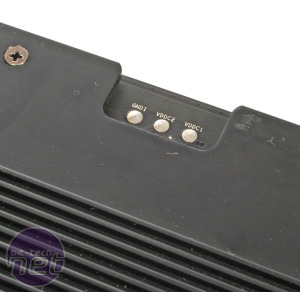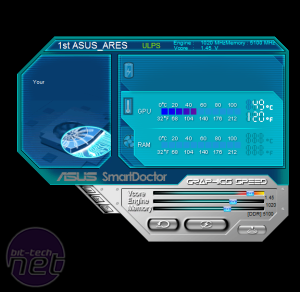
Overclocking
If we’re being honest, at this point we were a little disappointed with the Ares. At its factory settings it soundly beat out a stock HD 5970 but offered little over the cheaper Sapphire Toxic. What's more, it was also significantly louder than the Toxic. To try and improve things we booted up Asus Smart Doctor overclocking tool to see if we could tease any extra speed out of the dual HD 5970 GPUs.The Asus Smart Doctor application isn't the prettiest overclocking tool in the world, neither is it the easiest to use or the most clear, but it does allow users to overvolt the GPU. This is a killer feature and something we're seeing in more and more GPU overclocking tools.
Overvolting the GPU helps overclocking as it increases the strength of the electrical pulses sent to the chip. This means the pulses arrive with more force, which helps the GPU register each individual pulse. This is critical when you're increasing the speed at which the chip runs, as it will have less time to register each pulse.
With the vcore of the GPU raised from 1.174V to a brave 1.45V we managed to push the Ares to an epic core speed of 1.02GHz and a memory speed of 5.1GHz. These speeds and voltages forced the fan to spin up dramatically, which you wouldn’t want on an everyday basis, but they also provided a hefty chunk more performance too.


Multimeter points are accessible on the rear of the card so you can check you overvolt has been applied correctly. Click to Enlarge
In Crysis at 1,920 x 1,200 with 4x AA the minimum framerates rose by 3fps to 30fps and at 2,560 x 1,600 with AA disabled the minimum rose from a jerky 21fps to a so-close-to-playable 24fps. These figures also put the Ares ahead of the Toxic.
Conclusion
The Asus Ares can’t be assessed in a rational way as its not been made for rational people - anybody with any sense would buy a stock HD 5970, which retails for nearly £700 less. This means it’s been made for people to whom money is no object, and when viewed in this way the card succeeds to a degree as it’s biblically quick and very overclockable. It is also noisy, however, and since the deaf millionaire computer enthusiast market is even smaller than the regular millionaire computer enthusiast market, we have to mark this as a major negative.There is also the fact that if you drop £1,200 on a graphics car you expect it to be the best, but at factory speeds it’s not, as the Toxic comes with a more aggressive overclock. This can be solved through use of Smart Doctor though, and there is no denying that spending an afternoon trying to get the best out of the Ares was a lot of fun. The bling factor of having two 1GHz GPUs sat in your PC also cant be forgotten.
For mere mortals the Ares isn’t even a consideration - it’s far too expensive. For playboy millionaires living off daddy’s trust fund though it’s worth considering, however we’d get the Toxic as its just as rare and far easier to live with.
- Performance
- x
- x
- x
- x
- x
- x
- x
- x
- x
- -
- 9/10
- Features
- x
- x
- x
- x
- x
- x
- x
- -
- -
- -
- 7/10
- Value
- x
- x
- x
- x
- -
- -
- -
- -
- -
- -
- 4/10
- Overall
- x
- x
- x
- x
- x
- x
- x
- -
- -
- -
- 7/10

MSI MPG Velox 100R Chassis Review
October 14 2021 | 15:04








Want to comment? Please log in.